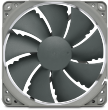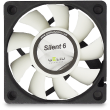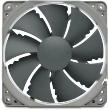120mm Real Silent Basic Cooling fan Discontinued | |
| More variations available Show | |
Nexus 120mm Real Silent Basic Cooling fan
The Nexus 120mm Real Silent Case Fan is the ultimate solution to bring some extra airflow in your quiet computer. Don’t you just hate it when you have build a nice and quiet computer and it turns out that your high-end components are producing so much heat the temperatures in your computer case are getting too high? The Nexus Real Silent case fan is the solution for you. It provides the extra airflow your pc may require without being noticeable noise wise.

The Nexus 120mm Real Silent case fan is equipped with a double sided 4-pin power connector and a 3-pin motherboard connector. This allows you to connect the case fan directly to the power supply or to the motherboard. Inside the package a set of 4 ultra-soft silicone fan mounts are supplied to reduce any vibration the fan may cause.
Features
- Award winning cooling fan
- Supplied with four silicone fan mounts
- Very quiet, 18 db(A) @ 1000 RPM, 36.9 CFM
- Three year warranty
Review
Xbitlabs.com
Look at the straight line of the noise level: you won’t hear this fan at all up until 840 RPM. After that you can hear the airflow created by the fan, but not the fan itself. By the way, the airflow is pretty significant, even though it is a little lower than by the leading solutions of our today’s test session. Good job, Nexus!
| Specifications | 120mm Basic |
|---|---|
| Model number | D12SL-12 |
| Dimensions | 120x120x25mm |
| Fan mounts | 4 pieces Ultra-Soft silicone Fan Mounts |
| Weight | 123 grams |
| Voltage | 12 Volts |
| Voltage Range | 6.5 ~13.8 Volts |
| Input Current | 0.30 Amp Max |
| Rotation Speed | 1000 RPM (+/-10%) |
| Acoustic Noise | 18 dB(A)* |
| Airflow | 36.87CFM |
| Static Pressure | 1.2mmH2O |
| Starting voltage | 7 Volts |
| Operation Temperature | -10 to +65 C |
| Warranty | 36 months |
| EAN barcode | 8717371698126 |
| Specifications | 120mm Basic |
|---|---|
| Model number | D12SL-12 |
| Dimensions | 120x120x25mm |
| Fan mounts | 4 pieces Ultra-Soft silicone Fan Mounts |
| Weight | 123 grams |
| Voltage | 12 Volts |
| Voltage Range | 6.5 ~13.8 Volts |
| Input Current | 0.30 Amp Max |
| Rotation Speed | 1000 RPM (+/-10%) |
| Acoustic Noise | 18 dB(A)* |
| Airflow | 36.87CFM |
| Static Pressure | 1.2mmH2O |
| Starting voltage | 7 Volts |
| Operation Temperature | -10 to +65 C |
| Warranty | 36 months |
| EAN barcode | 8717371698126 |
Customer Reviews
Nexus fan
Real silent indeed!!!
Greatest fan I have ever bought
A really great product overall, at top speed you can only hear the air moving and if you decrease the voltage you get a totally silent fan that still gives good cooling.
Nexus Basic 120mm
This is absolutely my go-to 120mm fan. I’ve used five or six (so far) in a number of different PCs, and they’re very quiet - superb price, too.
Bargain. SPCR reference fan.
I’ve previously used Noctua NF-12s for various builds but I’ve seen the occasional positive review of these. I needed to build a few bargain machines so thought I’d buy a few to try.
Results:
- Basic packaging vs Noctua = but who knows once installed!
- Colour (black and white) works much better than brown/beige in any case (so I’ve just been told!)
- Includes 4 good soft mounts.
- Very, very quiet. At under 800 rpm I believe I can’t hear them (ear next to fan not at 1m). At max speed all I hear is air moving! The reviews I have seen say that a Noctua moves a very small amount of air move (but compare prices).
- Minus point is they are wired with both 4 min Molex and 3 pin fan cables so with 4 in a case there is a lot of cabling to hide.
- Very, very impressed (I’ve ordered some more). I’m not really certain why 120mm Noctua are worth 2.5 times the price. Cheers Stephen.
FAQ
How do I measure fan size?
The size of fan you need will generally be determined by the size of the fan fitting position in your PC case. The sizes of all the fans on our website are shown as measured along any one of the fan’s four sides, NOT the distance between the fan’s screw holes! Our most popular fan size is 120mm, followed by 80mm. This isn’t really dictated by customer preference, but more by recent designs of PC cases.
As for the thickness (depth) of the fan, generally 25mm (1 inch) is by far the most common depth, although smaller fans can have shallower depths such as 15mm or even 10mm. All our fans are 25mm thick unless otherwise stated. If you have any questions about which fan you should order, please don’t hesitate to get in touch.
If you know the distance between the fan mounting screw holes but don’t know what fan size to order, please see the following table. Note that the mounting hole measurements shown below are taken horizontally or vertically between the holes and not diagonally.
Screw hole spacings and fan sizes
Space Between Screw Holes Fan Size 32mm 40mm 40mm 50mm 50mm 60mm 60mm 70mm 72mm 80mm 83mm 92mm 105mm 120mm I received a small cable (resistor) with my fan; what is it for?
The resistor cable (also called Ultra Low Noise or ULN cable) is designed to allow the fan to run slightly slower for even quieter operation. The benefit in lower running noise is significant. Although the airflow will be reduced slightly, this usually has minimal effect on PC temperature. We would generally recommend using the ULN resistor cable for best results in almost all circumstances.
How can I tell which way the air blows through the fan?
Hold the fan so that the round fan sticker is facing you. You are looking at the rear of the fan. When you plug the fan in, the air will be blowing towards you. If you want a fan to act as an air intake, then the fan sticker will be facing the inside of the case. Some fans also have two small arrows moulded into their plastic housing - one arrow shows the direction of airflow, and the other (at 90°) shows the direction of blade rotation.
Is it possible to use a 4-pin PWM fan or CPU cooler with a motherboard which has only 3-pin fan headers on it?
Electrically, there is no problem doing this - the fourth pin on the fan cable is used purely for PWM control and is not needed in order for the fan to run. So you can plug the 4-pin fan connector onto the 3-pin motherboard fan header, leaving the fourth pin not connected to anything. The fan will potentially run at full speed, so if you would like to reduce the speed of the fan you will need to adjust the fan speed setting in your BIOS or use fan control software such as SpeedFan in Windows.
The only other problem to consider is that occasionally, components immediately adjacent to the motherboard fan header can get in the way of the larger 4-pin fan connector, physically preventing connection. This problem also occurs if you try to use an in-line fan speed controller such as the one made by Gelid.
Another avenue to explore is the possibility of using a bay-mounted fan controller. Several models are available now which provide 4-pin fan headers, so this is an easy way to use 4-pin PWM fans in a PC system which has only 3-pin fan headers on its motherboards. When using this method, you may find it necessary to disable any fan warning settings in your motherboard BIOS, since the motherboard may incorrectly believe that its CPU fan has failed when the fan is connected to a fan controller rather than directly to the motherboard itself.
Top Quiet Fans

Noctua NF-P12 REDUX PWM 12V 1700RPM 120mm Quiet Case Fan

Noctua NF-A12x25 PWM chromax.black.swap 12V 2000RPM 120mm Fan

Noctua NF-R8 REDUX 12V 1200RPM 80mm Quiet Case Fan

Gelid Silent 6, 60mm Quiet Case Fan

Noctua NF-F12 iPPC PWM 12V 2000RPM 120mm High Performance Fan

Noctua NF-F12 iPPC PWM 12V 3000RPM 120mm High Performance Fan

Noctua NF-P12 REDUX PWM 12V 1300RPM 120mm Quiet Case Fan

Noctua NF-A12x25 PWM 12V 2000RPM 120mm Ultimate Quality Quiet Fan

Noctua NF-A6x25 PWM 12V 3000RPM 60x25mm Low Noise Fan

Noctua NF-S12B REDUX 12V 700RPM 120mm Quiet Case Fan

